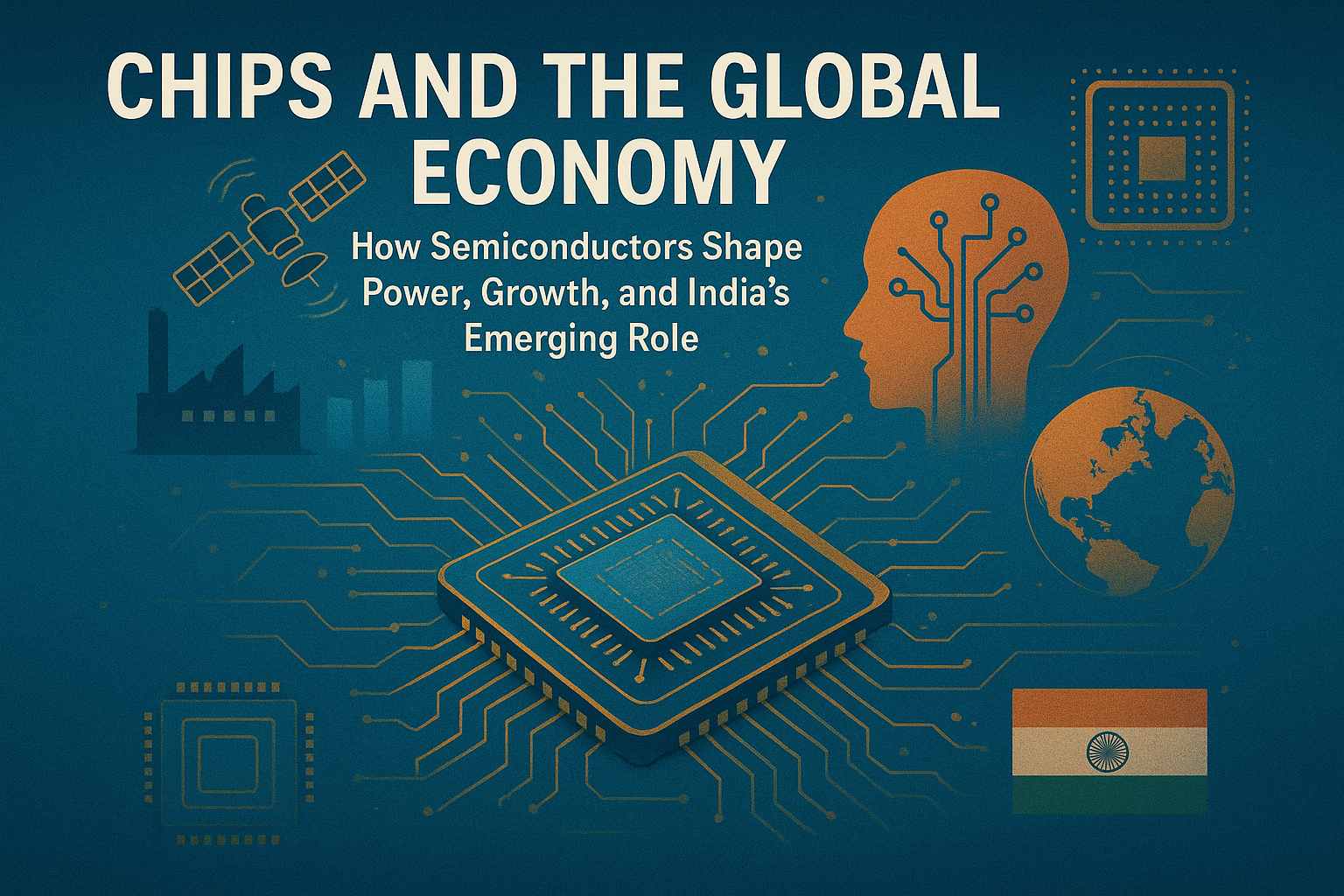Introduction: Chips as the ‘New Oil’ of the 21st Century
In the 20th century, oil determined global power, wealth, and conflicts. In the 21st century, the same is true for semiconductor chips. These tiny marvels of silicon power our smartphones, laptops, electric vehicles, satellites, fighter jets, cloud servers, and artificial intelligence systems.
The global economy literally runs on chips—and nations are racing to secure their place in this trillion-dollar industry. For India, this race presents both challenges and once-in-a-century opportunities.
1. From Transistors to Today: The Origins of Chips
The story of chips begins in the 1940s and 50s with the invention of the transistor at Bell Labs, followed by the first integrated circuits. In 1971, Intel launched the first microprocessor (Intel 4004), igniting the personal computing revolution.
Since then, Moore’s Law—the principle that chip power doubles every two years—has driven exponential growth. Today, advanced processors contain tens of billions of transistors, powering technologies from smartphones to artificial intelligence.
2. The Scale of the Semiconductor Economy
The semiconductor industry is one of the largest and most vital sectors of the global economy:
- 2024 market size: ~$600 billion.
- Projected 2030 size: Over $1 trillion, fuelled by demand in AI, 5G, IoT, electric vehicles, and cloud computing.
- Chips directly or indirectly support $100+ trillion in global GDP, powering industries from consumer electronics to defence.
Chips are not just products—they are value multipliers that enable trillion-dollar companies like Apple, Tesla, and Microsoft to thrive.
3. Who Makes the World’s Chips?
The global semiconductor supply chain is deeply interconnected yet highly concentrated:
- Taiwan (TSMC): Manufactures ~60% of the world’s chips and over 90% of the most advanced chips.
- South Korea (Samsung, SK Hynix): Dominates memory chips (DRAM, NAND).
- United States (Intel, Nvidia, Qualcomm, AMD): Leads in design, AI chips, and cutting-edge R&D.
- China (SMIC, Huawei): Growing fast but restricted in advanced chipmaking due to U.S. sanctions.
- Japan & Netherlands (ASML, Tokyo Electron): Control critical chipmaking equipment, especially photolithography.
This dependence makes the industry both collaborative and vulnerable—a single disruption can ripple across the globe.
4. Chips in Geopolitics: Technology as Power
Semiconductors are not just about smartphones or cars—they’re about national security and global influence.
- US–China Rivalry: The U.S. has imposed export bans on advanced chips and tools to slow China’s military and AI ambitions. China, in turn, is investing billions in self-sufficiency.
- Taiwan’s Silicon Shield: Taiwan’s chip dominance makes it a critical flashpoint—any conflict could destabilize the global economy.
- Chip Alliances: Nations are forming blocs, like the US-Taiwan-South Korea-Japan Chip 4 Alliance, while the EU has launched the European Chips Act to reduce reliance on Asia.
In the 21st century, control over chips is control over power.
5. Chips in Daily Life and Future Tech
Chips are everywhere:
- Smartphones & laptops (Apple, Samsung, Lenovo).
- Automobiles: EVs use 3,000–5,000 chips per vehicle.
- Defence: Fighter jets, drones, and cyberwarfare systems rely on advanced processors.
- Healthcare: MRI machines, robotic surgery, AI-based diagnostics.
- AI & Cloud: Chips like Nvidia’s GPUs are the backbone of AI models, including ChatGPT.
Emerging tech—autonomous vehicles, quantum computing, and the metaverse—will only intensify chip demand.
6. India’s Current Status in the Semiconductor Race
Strengths Today
- Design Hub: India contributes 20%+ of the global chip design workforce, with giants like Intel, Qualcomm, Nvidia, and AMD running large R&D centres.
- Massive Market: India is the second-largest smartphone market and a fast-growing hub for EVs, IoT, and AI adoption.
- Rising Demand: By 2030, India’s semiconductor demand is expected to exceed $110 billion annually.
Weaknesses
- India currently has no large-scale chip fabs (manufacturing plants) and imports almost all semiconductors.
- The lack of domestic production makes India highly dependent and vulnerable to supply chain shocks.
7. Government Push: Building India’s Silicon Dream
Recognizing the strategic importance of chips, the Indian government is making bold moves:
- India Semiconductor Mission (ISM): $10 billion incentive program to attract global chipmakers.
- PLI Scheme: To boost electronics and semiconductor manufacturing.
- Recent Developments:
- Micron (USA): Building a $2.75 billion assembly & testing facility in Gujarat.
- Applied Materials: Opening a major semiconductor R&D lab in India.
- Vedanta–Foxconn: Exploring large-scale chip fabrication projects.
These moves show India’s intent to move from being just a design hub to becoming part of the global supply chain.
8. India’s Future Prospects
- Strategic Advantage: As the U.S. and allies look for supply chain alternatives beyond China, India’s democratic and stable environment makes it attractive.
- Talent Powerhouse: India produces 1.5 million+ engineers yearly, giving it a strong base for chip design and future manufacturing.
- Fabless Model First: India could succeed initially as a fabless hub, focusing on design while outsourcing production.
- AI, EV, 5G Push: With India’s booming digital economy, local chipmaking could give it an edge in these high-growth areas.
- Long-Term Goal: If successful, India could become a global semiconductor hub by the 2030s, reducing dependence and reshaping global supply chains.
9. Challenges Ahead
- Capital-Intensive: A single fab cost $10–15 billion to set up.
- Infrastructure Gaps: Stable electricity, water, logistics, and ecosystem readiness remain concerns.
- Global Competition: Taiwan, Korea, and the U.S. already dominate advanced nodes. India must carve its niche strategically.
10. Conclusion: Chips as the Currency of the Future
Chips are the currency of power, growth, and innovation in today’s world. They decide who leads in AI, defence, healthcare, and digital economies.
Globally, the semiconductor industry is a battleground of economics and geopolitics. For India, it is a once-in-a-generation chance to move up the value chain—from a net importer to a global hub.
If India successfully builds its semiconductor ecosystem, it won’t just secure its own digital future but also contribute to a more resilient, diversified, and balanced global chip industry.
In short, just as oil defined the 20th century, chips will define the 21st—and India wants a seat at that table.

Leave a Reply